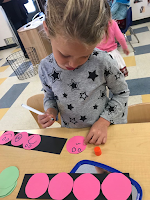This week we focused on our emotions and feelings. It is important to know we have many kinds of moods. To be able to verbalize what we are feeling and give validation is a crucial skill to have in life.
We started this off with our 'How are you feeling today" chart.
After circle time we placed this chart on our back wall for the children to update their feelings! It was fascinating to see how many times the children's moods changed.
Our Many Faces
Circle and markers was a fun way for the children to illustrate different feelings and expressions they have. A mirror helped them see what their face looked like while having a particular feeling.Bela Riva made a sad face which reminded her about when she was sad while being sick in the car.
This was a great way to remember and communicate the different feelings we have.
Mina "My mad face."
Rozie (after checking her angry face in the mirror) "My nose looks bumpy when I'm angry." What a great observation! It made some of us want to recheck the mirror to see what our faces do when were upset.
Menachem "I feel shocked sometimes at Arik"
What makes YOU happy?
It is important to recognize the things that put us in a good mood or feel happy. The children were invited to add what made them happy to our easel.
We then took it to the next level by understanding how each person is unique and different in what makes them happy. Mina reviewing the pictures of her friends answers.
It is quite a challenging but important skill to know how someone else feels happy and that might not be the same as you.
During our many circle times this week, when talking about different feelings we had a big mirror for the children to check their own facial expressions and to see how they were feeling.
Batya, after checking herself in the mirror, gave a big skip and let us all know she was excited today!
Moshe using different materials to create his happy face.
Motty had fun building faces.
Rozie and Hannah playing with Mr. potato head as a way to show different feelings.
As the children were 'trying on' different mouth expressions they noticed their eyes changed!
These masks also helped us role play how to help someone who is feeling sad. Ari saying kind words to Shayna who was pretending to feel sad.
Emotions head band game
Each child had a turn to wear a different emotion picture on their head. Without looking at the picture they had to guess which one they got by looking at their friends facial expressions.Self control
It is okay to be mad or sad sometimes but what do we do about it? Next week we will focus on how we should respond when we are angry. To prepare for this we did many activities to help with self control.
Why is self-control so important?
Self-control is not a skill most preschool children have mastered. However, many professionals believe that it is a strong indicator of kindergarten readiness. After all, kids need self-control to be able to sit still, pay attention, follow directions, and control their impulses.
Each color representing a different physical action helped the children practice self- control.
Hannah holding up yellow which meant tiptoeing. It was challenging at first when some of the children wanted to run up to her and get there first!
Musical instruments during davening circle was a great way to practice self-control. At the end of each song when the Morah holds up a fist that signaled to stop their music.


















No comments :
Post a Comment